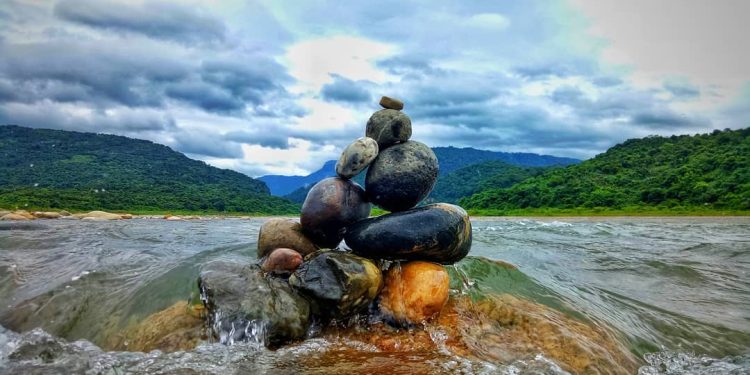Bholaganj is a notable tourist destination located just 33 kilometers from Sylhet. Long ago, it was used as a route to reach Shillong, the capital of the Indian state of Assam. Over time, a cable car named Bholaganj Ropeway has been established here. The region is also home to the country’s largest stone quarry. Tourists from various corners of the country come here to see the ropeway, the stone quarry, and the hills.
Bholaganj Ropeway
The Dhalai River, which flows from the Khasi Jaintia Hills of India, carries a large amount of stone during the monsoon season every year. Beneath the Dhalai River lies a vast stone mine. The Bholaganj Ropeway project was implemented by a British cableway engineering company at a cost of over 2.5 crore taka between 1964 and 1969. As part of the project, 120 towers were constructed for an 11-mile-long cableway from Bholaganj to Chatak, with four substations in between. The project included two diesel-powered electric powerhouses at both ends, a railway colony in Bholaganj, a school, a mosque, and a rest house.
Until 1994, stone extraction was done automatically with the help of a mining center, but due to a shortage of workforce, insufficient stone, and malfunctioning machines, the excavation machinery has been inactive for nearly 12 years. Interestingly, this area looks like a delta. The Dhalai River enters Bangladesh and splits into two, circling trees before meeting again. The Dhalai River merges with a lowland river near the sub-district of Kamijiganj. The area of the ropeway is about 100 acres, which makes this place very attractive to tourists.

Below Cherrapunji
Cherrapunji, known as the wettest place on Earth, is located in the hilly state of Meghalaya in India, upstream from the Dhalai River. Surrounded by the Khasi Jaintia Hills, the views in this state are truly picturesque. From the Bholaganj Ropeway area, one can enjoy the beautiful scenery of the hills. During the monsoon, the rainwater from Cherrapunji creates flash floods in the Dhalai River. While many refer to the Dhalai River as a dead river in the summer, it swells significantly during the rainy season.

Stone Collection Scene
During the dry season, stones are extracted from the Bholaganj quarry. In this method, workers first remove the sand from the top of the quarry. After digging a hole about 6-7 feet deep, water rises into the quarry. When the water rises, workers use shallow machinery to remove the water and extract stones.
Additionally, stones are also extracted using the “Shiver Boat” method. An empty boat is attached to a shallow machine engine. The engine’s fan rotates underwater, softening the soil and allowing the stones to surface. Other workers then collect the stones in the boat. This extraction scene is very enjoyable to watch, with thousands of workers involved.

Bholaganj Land Customs Station
Bholaganj hosts a land customs station through which import and export activities are conducted. Bangladeshi traders primarily import limestone through this station. Hundreds of trucks carrying limestone enter Bangladesh daily. This customs station is located at the zero line of the border, and observing the limestone import process is also interesting for tourists.
Utma Chora and Turang Chora
Close to Bholaganj are two more tourist spots: Utma Chora and Turang Chora. Many people visit Utma Chora and Turang Chora while exploring the white stones of Bholaganj. To reach Utma Chora from Bholaganj, you must first go to Doyar Bazar. If you tell the boatman taking you to Bholaganj, he will drop you at Doyar Bazar ghat. In that case, you might need to pay a little extra. Alternatively, you can inform them in advance while arranging the boat.
After reaching Doyar Bazar, take a CNG or bike for a fare of 30-50 taka per person to Charar Bazar. Once you get down at Charar Bazar, just ask someone for directions to Utma Chora. After walking for 10-15 minutes, you will reach the Uthamachra point. Walking from Charar Bazar to Turang chora takes about 30-40 minutes, but you can also take a bike from Charar Bazar if you prefer.
When returning to Sylhet, depending on your location, you can directly take a CNG from Charar Bazar/Doyar Bazar/Bholaganj to Ambar Khan in Sylhet.

How to Get Bholaganj?
From Ambar Khan in Sylhet, you can find CNGs, and from the Majumdar area, there are BRTA, local, and tourist buses to Bholaganj. These buses run every 20 minutes from 8 AM to 6 PM. For a fare of 70 taka per person, you can reach the white stone area near Bholaganj zero point. Local CNG fares range from 130 to 150 taka per person. If you reserve a CNG, the round trip fare will be 1200 to 1300 taka, accommodating up to 5 people.
Where to Eat?
There are no good quality hotels or restaurants at Bholaganj White Stone or Ghat No. 10. a few ordinary hotels serve rice, fish, and local food. On the way to Bholaganj, in the district town of Companiganj, you will find several medium-quality eateries such as Deshbandhu Restaurant, Alam Hotel, and Nabhin Restaurant and Maya Restaurant at Tukur Bazar. It’s advisable to have breakfast in Sylhet before heading to Bholaganj, so you can enjoy the whole day and return for dinner. However, for lunch, local hotels are the only option.
Bholaganj is an exceptional tourist hotspot in Sylhet, showcasing stunning landscapes and fascinating attractions like the Bholaganj Ropeway and its large stone quarry. The area’s captivating scenery and cultural heritage make it a perfect getaway. Additionally, places like Utam chora and Turang chora add to the charm. Whether seeking thrills or tranquillity, Bholaganj offers a unique and unforgettable experience.
